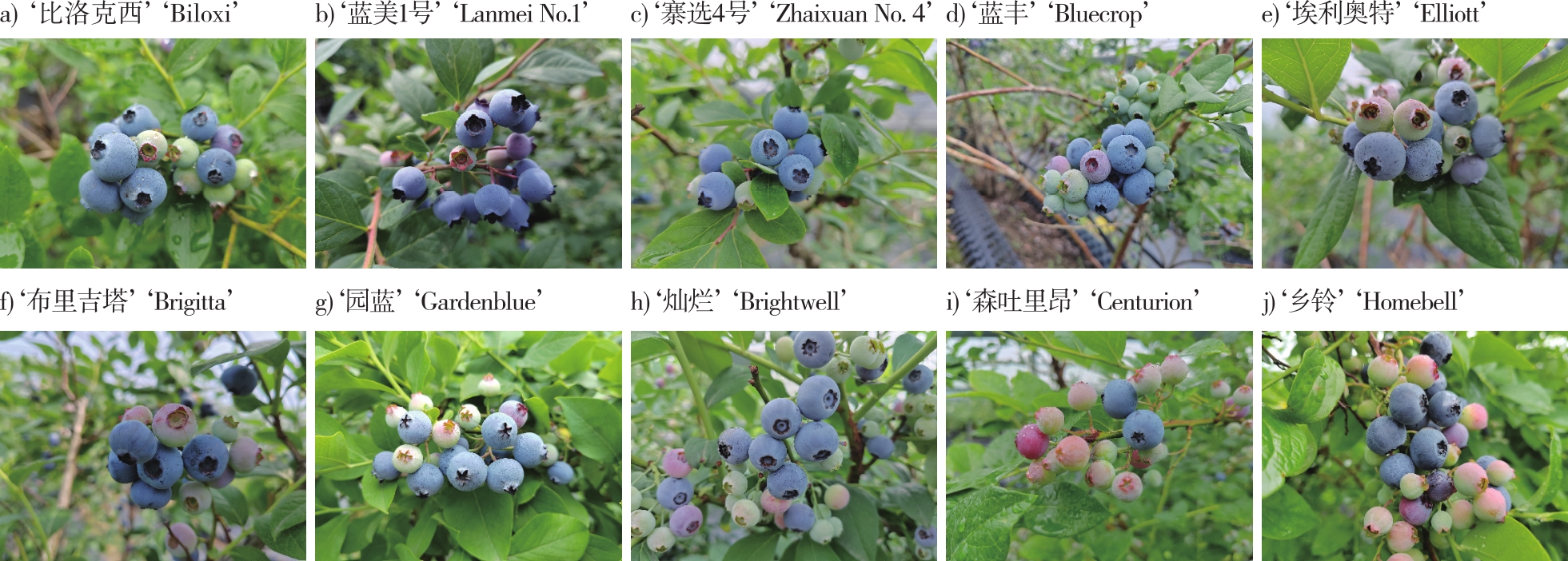【Objective】Blueberries (Vaccinium spp.) have garnered significant attention in recent years due to their rich content of bioactive compounds, particularly anthocyanins, which exhibit a wide range of physiological functions, including antioxidant, anti-inflammatory, and lipid-lowering effects. These functional properties make blueberries a valuable fruit for both dietary consumption and potential therapeutic applications. However, significant variations exist in fruit quality and functional component profiles among different blueberry cultivars. Understanding these variations is crucial for the selection of breeding parents, the development of functional food products, and the optimization of post-harvest processing techniques. This study aims to systematically compare the fruit quality characteristics and functional component profiles of ten high-anthocyanin blueberry cultivars, providing a scientific basis for the selection of fresh-eating varieties, the development of functional products, and the identification of superior breeding materials. 【Method】Ten high-anthocyanin blueberry cultivars, including southern highbush, northern highbush, and rabbiteye cultivars, were selected for this study. The fruits were harvested from the experimental blueberry orchard at the Nanjing Lishui Research Base of the Institute of Botany, Jiangsu Province and Chinese Academy of Sciences, during the period from May to July in 2024. The study focused on evaluating the external characteristics (color, fruit diameter, fruit weight and firmness), nutritional components (soluble solids content, total acid content and solid-acid ratio), and functional components (polyphenols, anthocyanins, flavonoids and ellagic acid) of both whole fruits and fruit peels. The content of these components was measured using standardized methods, and correlation and cluster analyses were conducted to comprehensively evaluate the fruit quality. The study aimed to identify the key factors influencing the functional and nutritional properties of blueberries and to determine the relationships between these factors.【Result】Among all the measured indicators, the coefficient of variation for anthocyanin content was the highest (27.16%), followed by total acid content (26.61%), while the variation in soluble solid content was the lowest (2.84%). In terms of functional components, cultivars such as ‘Centurion’, ‘Elliott’, ‘Gardenblue’, ‘Zhaixuan No.4’, and ‘Lanmei No.1’ exhibited higher anthocyanin content. Specifically, ‘Centurion’ had the highest anthocyanin content in the whole fruit (3.09 mg/g), while ‘Elliott’ showed the highest anthocyanin content in the peel (41.92 mg/g). Polyphenol, flavonoid, and ellagic acid contents were significantly positively correlated with anthocyanin content, indicating a close relationship among these functional components. Additionally, the peel mass fraction was positively correlated with the content of functional components, suggesting that thicker peels are associated with higher levels of bioactive compounds. In terms of external fruit characteristics, ‘Brigitta’ had the largest single fruit weight (2.42 g), followed by ‘Brightwell’ and ‘Centurion’. ‘Lanmei No.1’ exhibited the most rounded fruit shape, while ‘Elliott’ had the flattest shape. Cultivars with more abundant fruit wax, such as ‘Bluecrop’, ‘Brigitta’ and ‘Brightwell’, showed higher fruit firmness and better storage performance. The analysis of the soluble solids-to-acid ratio (SSR) revealed that cultivars like ‘Zhaixuan No.4’, ‘Brightwell’, ‘Bluecrop’ and ‘Gardenblue’ had SSR values above 20, indicating a sweeter taste and making them more suitable for fresh consumption.【Conclusion】Among the ten cultivars studied, ‘Centurion’, ‘Elliott’, ‘Gardenblue’, ‘Homebell’ and ‘Zhaixuan No.4’ exhibited high levels of functional components, particularly anthocyanins, making them ideal candidates for the extraction of bioactive compounds and as breeding parents for high-nutrition and health-promoting blueberry varieties. On the other hand, cultivars such as ‘Bluecrop’, ‘Brigitta’ and ‘Brightwell’, with their higher SSR values and superior external qualities, are more suitable for the fresh fruit market. The study also highlighted that thicker peels are associated with higher functional component content, suggesting that cultivars with thicker peels are more suitable for processing and the extraction of bioactive compounds. Furthermore, cultivars with more abundant fruit wax demonstrated better storage performance, providing new insights for post-harvest preservation technologies in blueberries. This study systematically compared the fruit quality of ten high-anthocyanin blueberry cultivars in the Nanjing region, revealing significant differences in functional component content and external characteristics among the cultivars. The findings provide a scientific basis for blueberry breeding and processing, particularly for the selection of high-anthocyanin cultivars and the development of functional products.
 PDF(33421 KB)
PDF(33421 KB)


 PDF(33421 KB)
PDF(33421 KB)
 PDF(33421 KB)
PDF(33421 KB)
